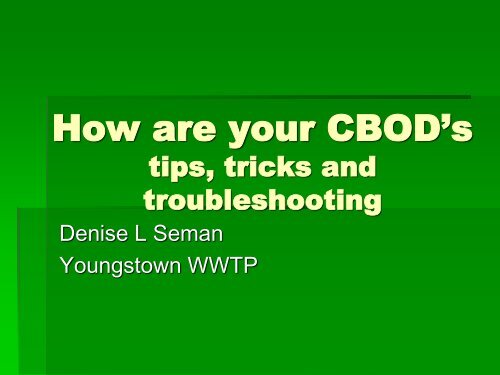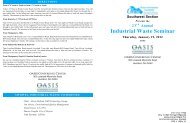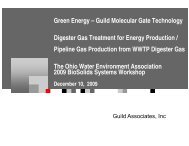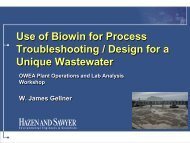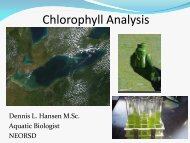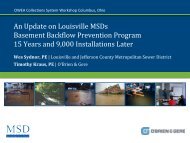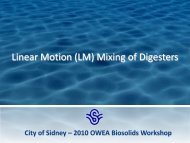How are your CBOD's - Ohio Water Environment Association
How are your CBOD's - Ohio Water Environment Association
How are your CBOD's - Ohio Water Environment Association
You also want an ePaper? Increase the reach of your titles
YUMPU automatically turns print PDFs into web optimized ePapers that Google loves.
<strong>How</strong> <strong>are</strong> <strong>your</strong> CBOD’stips, tricks andtroubleshootingDenise L SemanYoungstown WWTP
• CBOD’s: The test we love to hate• Assumed by many to be an “easy” test• Many variables in performing this test• Too many things that can go wrong
CBOD basics• Carbonaceous Biochemical OxygenDemand• Measures the potential of wastewater(and other waters) to deplete the oxygenlevel of the receiving waters
• CBOD is a subset of BOD• BOD looks at both carbonaceous andnitrogenous biochemical oxygen demand• It can be used to monitor plant operatingefficiency by determining percent removalof BOD/CBOD between influent andeffluent streams
• CBOD test is frequently used to determinethe extent a waste stream will contaminate/pollute a receiving stream by depriving theorganisms in the stream of oxygen
• Unfortunately, the BOD/ CBOD test is theONE test that is most likely to generateinvalid data if adequate precautions <strong>are</strong>n’ttaken to ensure the quality of the test
• 5 days is the designated time, which allowsfor about 60 to 70% of available material tobe consumed
CBOD Trivia
• The reason for 5 days is supposed to bethe length of time it took for water from theriver Thames to flow from London to theocean• This was established by the Royal Commissionon Sewage Disposal in 1908
• The US determined that at 5 days between60 and 70% of total BOD was exertedduring the incubation period…. afterinvestigating incubations of 1, 2, 5, 10 and20 days.
• CBOD will never be higher than BOD• CBOD can be equal to BOD if there is nonitrogenous uptake of oxygen• There is a correlation between COD andBOD. You can use this determine dilutionranges on new sample sites
To determine CBOD rangefrom COD• Lowest dilution:• (2/ COD value of sample) * 300• Highest dilution:• (5/COD value of sample) * 300• This gives a beginning range to set upwith
Method Approval• Standard Methods 5210 B–2001• Includes use of optical and luminescenceDO technology
• Samples <strong>are</strong> 5 days, not 4 or 6 and“adjusted”• Pretreat samples if pH isn’t between 6.0and 8.0 (dilute H2SO4 or NaOH). Ifpretreated, final pH should be between 7and 7.2
• Pretreat samples so temp. is 20+/- 3C• Adjust sample DO down if supersaturated• (shake or bubble if DO of sample is greaterthan 9 mg/L)
• Remove any residual chlorine• Chlorine will usually dissipate upon standingfor 1 to 2 hours)• If necessary, perform a titration with Na2SO3to determine required amount needed toremove chlorine. DO NOT ADD TO EXCESS!!
Dilution <strong>Water</strong>• Distilled, tap or receiving water• Free of metals and toxic substances• Deionized water may containmicroorganisms and organics, making itunsuitable for dilution water
• DO of dilution water should be at least 7.5• Glass is preferred container for storage/prep of dilution water• Add 1 mL each of phosphate buffer,Magnesium sulfate, Calcium chloride, andferric chloride per liter of dilution water
• Temperature should be 20 +/- 3 C• Prep<strong>are</strong> dilution water immediately beforeuse unless blanks show water is stable ifheld longer• Do NOT add oxidizing agents or exposedilution water to UV light in order to bringdepletion into range
Seed Preparation• Preferred seed is obtained from abiological treatment system processingthe waste• Synthetic seed may be used if there is noviable option of a natural seed source
• Do not filter seed source• Do not use chlorinated streams as a seedsource• Supernate from settled domesticwastewater, primary effluent, diluted mixedliquor <strong>are</strong> all acceptable sources of seed
• Seed uptake should be between 0.6 and1.0 mg/L to allow for seeded samples to fallinto the “take 2, leave 1 range”• Seed controls should be run for every set ofBOD/ CBOD
• Ideally, there should be 3 seed controlbottles, but at minimum – no less than 2 inorder to get an accurate seed value for therun
Sample Prep• Bring samples to 20 +/- 3C beforemaking dilutions• Check pH of sample• If sample’s pH is outside the range of 6.0 to8.0, adjust with sulfuric acid or sodiumhydroxide to a pH of 7.0 to 7.2• Always seed samples that have pH adjusted
• When making dilutions, sample volumeshould not be less than 1% of bottle volume• If you <strong>are</strong> using the most common sizeBOD bottle, it is 300 mL. Therefore, theamount of sample you use to makedilutions cannot be less than 3 mL• You may need to do a serial dilution toaccomplish lower values
Quality Control• Only bottles that give a minimal depletionof 2 mg/L and have a residual of at least1.0 mg/L DO can be calculated• GGA is used to determine accuracy andprecision of the BOD and should beincluded with every batch of samples.
• Seed control check should be 3 bottles,different dilutions so as to allow thesmallest dilution to show an uptake of 2mg/L and the largest to have a 1.0 mg/Lresidual. These should be included withevery batch
• Blank check is used to monitor the dilutionwater quality and should be set up withevery batch of samples as well.• If <strong>your</strong> blanks fail, <strong>your</strong> test data is invalid.Data may be reported out, with a qualifyingstatement explaining the blank failed.• Data is still invalid, and corrective MUST betaken
Tips & Tricks
• Always start with clean glassw<strong>are</strong>• Make sure the bod bottles, dilution water bottleand pipettes <strong>are</strong> scrupulously clean• Don’t use plastic carboy for dilution water.Plastic leaches into water, and the valve is abreeding ground for bacteria
• Make sure you transfer seed, sample anddilution water to bottles without introducingair.• Ideally, prep 3 bottles for each sample toallow for a variety of uptakes per site• Not all 3 need to meet the take 2, leave 1 rulefor valid results.
• Make sure to add nutrient to bottles wherethere is little to no dilution water present• If sample volumes <strong>are</strong> between 150 to 200mL, add 0.1 mL of each nutrient directly tothe bod bottle
• If sample volumes <strong>are</strong> between 200 to 250mL, add 0.2 mL of each nutrient directly tothe bod bottle• If sample volumes <strong>are</strong> between 250 to 300mL, add 0.3 mL of each nutrient directly toeach bod bottle
• Make sure the DO probe is calibratedcorrectly• Rinse the probe between every bottle• Allow the probe to stabilize beforerecording the reading
• Make sure dilution water is stable, with agood pH and DO• Samples <strong>are</strong> incubated for 5 days +/- 6hours
Troubleshooting
• Final DO of blank higher than initial DO:• Check on calibration techniques• Check to see if samples <strong>are</strong> incubating in dark– if too much light gets in, photosynthesis canoccur and drive final DO higher.
• Was the dilution water supersaturated?• Were bubbles introduced into blank whenprepping it?
• Too much uptake on blank DO:• If there is greater than 0.20 mg/L uptake forblank sample, check the following items:
• Check calibration techniques• Are you using the same method every time?• If air calibrating, is there a chart showingspecific values for each barometric reading?• If air calibrating – is barometer set for “real”altitude, not corrected to sea level?
• Check stability of water• Are you storing it, and if so…for how long?• Do you make it up fresh?• When do you add <strong>your</strong> nutrients?
• Check quality of source water• Do you use tap water, distilled, deionized?• Do you use receiving stream water?• Where do you get it from?• Is the system clean?
• Check cleanliness of water storage container• Check transfer tubing, etc for possiblecontamination• Check cleanliness of BOD bottles
• GGA:• Glucose- glutamic acid• 6 mL solution to 300 mL BOD bottle• Average value is 198 mg/L• Variance is 30.5 mg/L• Range: 167.5 mg/L to 228.5 mg/L
• According to EPA/ NELAC interpretationpapers, every lab should determine theirown GGA values• Find the mean and standard deviation ofthe GGA, use these to determine the actualacceptable range for <strong>your</strong> lab – <strong>your</strong> GGAprep, seed, equipment, technician(s)
• LOW GGA:• Often occurs when using synthetic seed• GGA might be “old” – make fresh if you seevalues dropping off
• High GGA:• Failed to add nitrification inhibitor• Inhibitor is “old”• Dispenser doesn’t add correct amount• TCMP – 3 mg per 300 mL BOD bottle• ATU – 0.3 mL per 300 mL BOD bottle
• NOTE:• ATU (Allylthiourea) is an alternate form ofnitrification inhibitor• As a liquid, it goes into solution quickly• Not always effective during the 5 dayincubation period• Added in excess can create false high CBODresults
• TCMP:• 2-chloro-6-(trichloromethyl) pyridine• Doesn’t dissolve well• Most commercial preparations <strong>are</strong>n’t pureTCMP, allowing them to go into solution better
• High GGA:• Bottles may be overseeded.• Try setting up the GGA with smaller volumes ofseed
• CBOD value decreasing as sample volumeincreases:• Most likely toxicity of sample occurring, killing/impairing the seed• Do more than 3 dilutions on next sample toverify.
• REMEMBER:• Only 1 of the dilution series for eachsample has to meet the take 2, leave 1 rulefor valid results for the test
CBOD Math
• BOD/CBOD - unseeded• (D1 – D2)• P• D1 = initial DO• D2 = final DO• P = decimal volumetric fraction of sample used
• Unseeded, slightly easier• (Initial DO – Final DO) * 300•Volume of sample
• Seeded:• (D1 – D2) – ((S1 – S2)SF)•P• D1 = initial DO of sample• D2 = final DO of sample• S1 = initial DO of seed• S2 = final DO of seed• SF = seed factor• P = decimal volumetric fraction of sample used
• Better:• (D – SFC) * 300• sample volume• D = sample uptake (initial DO – final DO)• SFC = average mg/L uptake of the “good”seed bottles, times mL of seed in samplebottle
• Remember:• If uptake is less than 2.0 for the bottle, don’tuse that value• If final DO is less than 1.0, don’t use thatvalue• If dilution set shows non-linear values, don’treport the results
• If the BOD values get lower as the samplevolume increases, report value fromsmallest volume(toxicity).• Set the sample site above up with lowerdilutions to verify toxic effect• Set up matrix spike, and spike dup to meetQC requirements
• Matrix spike can show if sample has aninhibiting effect• MS/MSD should be evaluated bycalculating an RPD
• RPD: Relative Percent Difference• Absolute value of difference between thedups, divided by the average of thedups…expressed as a percent
QUIZ TIME
• True or False• Consistently high blanks (>0.2 mg/L) canbe an indication of poor quality sourcewater (such as distilled water).
• True. Organic material, one cause of highblanks, can be present even after distillingwater and also can be leached fromdeionization columns.
• TRUE or FALSE:• When a wastewater treatment plant usesultraviolet light to disinfect effluent, BODand CBOD samples taken downstreamfrom the disinfection point do not need tobe seeded because bacteria in the effluent<strong>are</strong> not killed by ultraviolet light but rather<strong>are</strong> unable to reproduce.
• False. Standard Methods 5210B says allsamples taken after disinfection must beseeded. Furthermore, unless it is known forcertain that sufficient viable bacteria <strong>are</strong>present in a sample, it must be seeded.
• TRUE or FALSE• The conversion of ammonia (NH3) tonitrate (NO3-), a process that depletesdissolved oxygen in a sample, does nottake place if a nitrification inhibitor is addedto the sample in accordance with themethod.
• True. This is the basis for the CBOD testand the reason CBOD results should belower than BOD results for the samesample when the sample includes nitrogenthat can be converted to ammonia
• TRUE or FALSE• The seed control bottle (used to determinethe seed correction for seeded samples)must deplete at least 2.0 mg/L of dissolvedoxygen to be considered valid.
• True. Standard Methods 5210B says validbottles must deplete at least 2.0 mg/L DOwhile leaving a residual DO of at least 1.0mg/L. It makes no exception for the seedcontrol bottle. (The 21st edition of StandardMethods no longer says the seed controlbottle must deplete between 0.60 and 1.00mg/L of DO.)
• Multiple Choice• What does the biochemical oxygen demandtest measure in a wastewater treatment plant?• A. The concentration of organic material in awaste sample.B. The concentration of organic material andreduced forms of nitrogen (e.g., ammonia) in awaste sample.C. The oxygen-depleting capacity of a wastesample.D. The dissolved-oxygen concentration of a wastesample.
• c. See Standard Methods Sec. 5210A(1).Concentration of organic material (a) isapproximated by the total organic carbon(TOC) test, organic material and reducedforms of nitrogen (b) by the TOC, ammoniaand nitrite tests, and dissolved oxygen (d)by the DO test.
• For which test or tests is it acceptable tostore dilution water (source water to whichnutrients and buffers have been added) inthe BOD incubator?• A. When testing BOD or CBOD.B. When testing CBOD, but not BOD.C. When testing BOD, but not CBOD.D. Only if testing ultimate BOD.
• b. Aging encourages growth of nitrifyingbacteria, which would bias BOD andultimate BOD results. For CBOD analysis,however, nitrifying bacteria <strong>are</strong> inhibited, sotheir presence would not have an effect onthe test results
• When analyzing effluent BOD from awastewater treatment plant that useschlorine disinfection, which of the followingreagents is the best choice toensure excess chlorine is removed beforeproceeding with the test?• A. Dilute sulfuric acid.B. Dilute sodium hydroxide.C. Sodium thiosulfate.D. Sodium sulfite.
• d. Sodium sulfite is the best choice. While,sodium thiosulfate and sodium sulfite bothremove unwanted chlorine, both also havean oxygen demand that, if added in excess,would bias the BOD result on the high side.Because sodium sulfite’s oxygen demandis less than that of sodium thiosulfate,sodium sulfite is the better choice. Sulfuricacid and sodium hydroxide both interferewith the BOD test
• Which of the following options most likelyprovides the best source water from whichto prep<strong>are</strong> dilution water for a BOD test?• A. Distilled water put through deionizationcolumns including an activated carbon filter.B. Purified drinking water purchased from adrugstore.C. Distilled water filtered using a 0.45 micron(e.g., fecal coliform) filter.D. <strong>Water</strong> taken from receiving waters at least1000 m downstream from a wastewater treatmentplant.
• a. Deionization columns including anactivated carbon filter that removesimpurities that might have made it throughthe distillation process. Drinking waterusually contains additives to give it “taste.”Filtering removes microscopic solidmaterial but not dissolved organic andinorganic material. <strong>Water</strong> downstream froma wastewater treatment plant (or elsewherein a stream) would most likely containmaterials that would interfere with the BODtest.
• What is the saturation point of dissolvedoxygen in water dependent upon?• A. Temperature, atmospheric pressure,elevation of the lab, and salinity.B. Temperature, atmospheric pressure, andsalinity.C. Temperature and salinity only.D. Atmospheric pressure and salinity only
• b. Temperature, atmospheric pressure, andsalinity all affect the saturation point ofdissolved oxygen in water. Even though theelevation of the lab has an effect onatmospheric pressure, knowing the lab’selevation is not enough, becauseatmospheric pressure changes from hour tohour and day to day.
• Questions?
• Contact info:• Denise Seman• Dseman@CityofYoungstownOH.com


